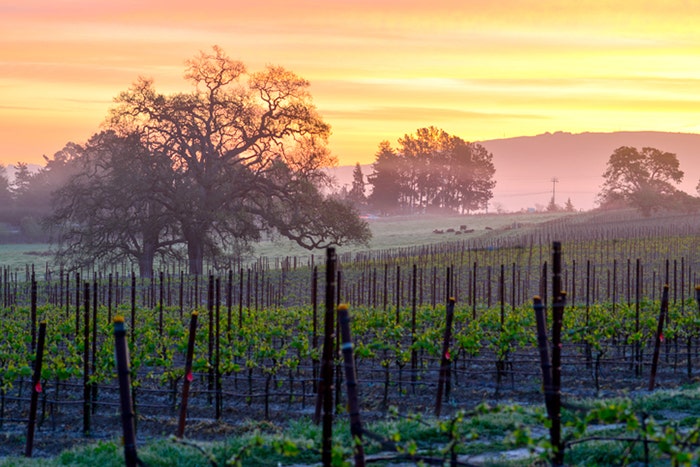Will the Petaluma Gap soon be made an official American Viticultural Area (AVA)? Winemakers and growers who work with the grapes from this area certainly hope so.
“People have been drinking Petaluma Gap wines for years, they just don’t know it,” says winemaker David Ramey. He makes one of California’s most stunning Syrahs from Rodgers Creek Vineyard, which lies within the boundaries of the Gap but is currently labeled as a Sonoma Coast wine.
The Sonoma Coast AVA, long considered unwieldy by many, was created in 1987, well before the nuances and differences of Sonoma County Pinot Noir were truly understood.
Ramey, and colleagues like Anna Keller of Keller Estate, Rickey Trombetta Stancliff of Trombetta Family Wines and Justin Seidenfeld of Rodney Strong Vineyards, all work with Petaluma Gap grapes. They want to give consumers more detail about where a wine’s grapes are grown.
“Saying Sonoma Coast when the vineyard is in the Petaluma Gap is akin to saying Côte de Beaune if the vineyard were in Chassagne-Montrachet,” says Ramey.
Rodgers Creek Vineyard sits 800 feet above sea level on the southwest face of Sonoma Mountain, also its own AVA. It sits within the path of cold Pacific air that defines the Petaluma Gap, marked by significant cooling winds that funnel through a 15-mile opening in the coastal mountain range.

It centers around the town of Petaluma, about 40 miles north of San Francisco. The town has a long agricultural history, and was once known as the egg basket of Sonoma County. In addition to poultry and wine, Petaluma is lauded for its artisan cheeses and beers. It’s the home of the Lagunitas Brewing Company.
The region’s grapes go to diverse producers: Kosta Browne, Arnot-Roberts, Bedrock, Flowers, La Follette, Wind Gap and WALT Wines. Each seeks the Petaluma Gap’s mix of cool-climate aromatics, acidity and a stark intensity of fruit.
Some 70-plus grape growers keep the area under vibrant cultivation. Vineyard sites include Gap’s Crown, Griffin’s Lair, Clary Ranch/Grand Vent, Sun Chase, La Cruz and several prestigious Sangiacomo sites.
The Petaluma Gap is marked by pronounced fog in the morning and late afternoon, and average daily temperature swings of up to 50°F. It enjoys midday sun and wicked afternoon winds that blow warmth over the vines.
As a result, the grapes tend to retain thicker skins, higher acidity and, thanks to substantial hangtime, powerful flavors.
“Someone once pointed out to me that a lot of regions get fog, but the Petaluma Gap owns the wind,” Keller says.
She thinks wind contributes a unique set of tough conditions on the vines, and that the combination of clay loam and sandy loam soils mixed with gravel coaxes minerality out of them, too. Many of the vineyards within the Petaluma Gap, specifically in and around Lakeville Highway, were once under water, part of the San Pablo Bay seabed.
Pinot Noirs from the Gap exhibit rich red and blue fruit alongside savory spice and wild herbs, while Chardonnay is often fairly bright in acidity, more tart than sweet.
But it’s the Syrah that’s most often revelatory. It offers a cool-climate temperament that’s as much about structure as power, with highlights of white pepper akin to the Northern Rhône. It’s something Ramey’s Syrah has in spades.
Most of what’s considered the Petaluma Gap lies currently within the Sonoma Coast appellation. As its own AVA, the Petaluma Gap would stretch from the Pacific Ocean at Tomales and Bodega bays and reach southeast to San Pablo Bay. Like nearby Carneros, which straddles Napa and Sonoma counties, the AVA would also include land in two counties, Sonoma and Marin.
Pinot Noir, Chardonnay and Syrah make up most of the plantings, about 4,000 acres in all. Pinot Noir accounts for 75% of that, with small yields the norm.
Five Petaluma Wines to Try (currently labeled within the Sonoma Coast AVA)
Ramey 2012 Rodgers Creek Vineyard Sonoma Coast Syrah; $65, 94 points. A bouquet of spicy black pepper intoxicates on the opening of this wine, followed by captivating waves of savory blackberry, leather and dust. The grapes are sourced from one of the producer’s coolest sites. With well-integrated, unobtrusive oak, the wine is soft and delicious now, offering plenty of meaty undertones, but will intrigue further through 2022.
Trombetta 2014 Gap’s Crown Vineyard Sonoma Coast Chardonnay; $50, 94 points. This is a gorgeous rendering of grape and place. Steely at first, it shows off the coolness of the site, yet it’s thick and inviting in apple skin, lemon bar and fresh-picked papaya. Mineral-driven, it never taxes the palate, instead releasing quiet waves of flavor and acidity.
Guarachi Family 2014 Sun Chase Vineyard Sonoma Coast Pinot Noir; $75, 94 points. From the proprietor’s sought-after vineyard site on the southern side of Sonoma Mountain near Gap’s Crown (at 1,400 feet), this wine is concentrated in cherry kirsch and orange peel, with a sultry hint of pine. Underlying flirtations with white pepper and cardamom provide further temptation, as the lengthy finish rambles on.
Keller Estate 2012 Rôtie Sonoma Coast Syrah-Viognier; $54, 93 points. Named for the famous wine from France and similarly made by co-fermenting Syrah with Viognier, this cool-climate offering features a delightfully juicy backbone of red fruit and savory earth. Floral and spicy, it remains elegant on the palate and will take on additional nuance in the cellar. Drink now through 2020.
Three Sticks 2013 Gap’s Crown Vineyard Sonoma Coast Pinot Noir; $65, 92 points. The second vintage by this producer from this highly regarded vineyard, this wine shows how racy the site can be, cooled from Petaluma Gap winds and fog and yet also robustly capable of ripe, rich red fruit. Measured acidity buoys a densely concentrated wine chewy and bright in pine, dark cherry, cranberry, strawberry and earth. The finish is lean and citrusy. Drink now through 2023.
Last Updated: May 4, 2023















